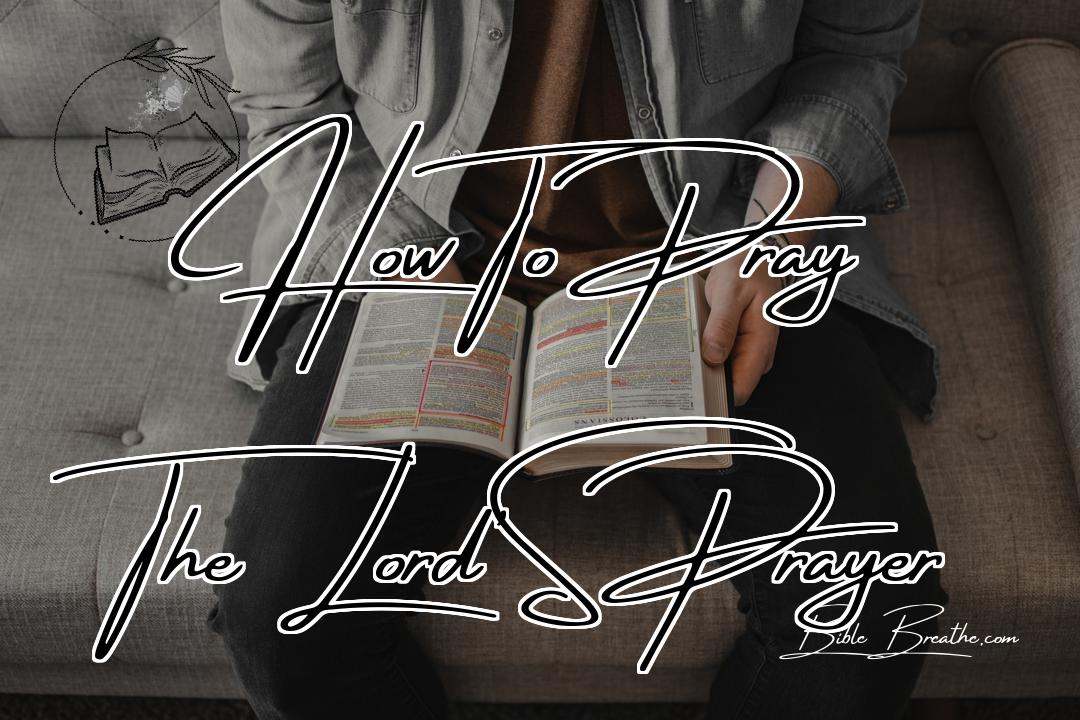Key Takeaways
- The Lord’s Prayer is a model prayer taught by Jesus in the New Testament, found in Matthew 6:9-13 and Luke 11:2-4.
- It is a guide for Christians on how to pray, and its structure and content have been a source of inspiration for many prayers throughout history.
- The prayer begins with addressing God as “Our Father in heaven,” emphasizing God’s paternal love and care for His children.
- The prayer then asks for God’s kingdom to come and His will to be done on earth as it is in heaven, expressing a desire for God’s reign and authority to be established on earth.
- The prayer also asks for daily bread, forgiveness of sins, and protection from temptation and evil.
- The Lord’s Prayer is often recited in corporate worship services and is a popular prayer for personal devotion, modeling a humility and dependence on God.
Introduction
What is the Lord’s Prayer?
The Lord’s Prayer is one of the most well-known prayers in the Bible, and it’s a great model for how to pray.
It’s not just a fancy phrase to recite; it’s a powerful tool to connect with God and bring our needs to Him.
Why is it Important to Learn the Lord’s Prayer?
Jesus taught us to pray this way, and it’s a vital part of our spiritual growth.
By learning the Lord’s Prayer, we can:
- Deepen our relationship with God: This prayer helps us focus on what’s truly important in our relationship with God.
- Find comfort in difficult times: The Lord’s Prayer is a reminder that God is always with us, even in the tough stuff.
- Improve our prayer life: This prayer is a great model for how to structure our own prayers and bring our needs to God.
What to Expect in this Article
In this article, we’ll break down the Lord’s Prayer and explore what each part means.
We’ll also look at some practical tips on how to pray the Lord’s Prayer and make it a part of our daily lives.
Understanding the Context of the Lord’s Prayer
Photo modified by BibleBreathe.com. Original photo by Pixabay on Pexels
History of the Lord’s Prayer
The Lord’s Prayer is one of the most well-known prayers in Christianity, but have you ever wondered where it came from?
Jesus taught it to His disciples as a model for prayer, and it’s been a cornerstone of Christian worship ever since. But what was the historical context in which Jesus taught this prayer?
In the Gospel of Matthew, Jesus is responding to His disciples’ request to teach them how to pray. They wanted to know the secret to effective prayer, and Jesus gave them this beautiful, simple, yet profound prayer.
Theological Significance of the Lord’s Prayer
So, what makes the Lord’s Prayer so special?
For one, it’s a template for prayer that covers all the bases: worship, confession, petition, and commitment. It’s a reminder that our prayers should be both personal and communal.
The Lord’s Prayer also reveals God’s character: it shows us that God is a loving Father who cares about our daily needs and desires. It’s a reminder that we can approach God with confidence and humility.
The Lord’s Prayer in Different Christian Traditions
The Lord’s Prayer has been a part of Christian worship for centuries, and it’s been interpreted and used in different ways across various Christian traditions.
In Catholic and Orthodox traditions, the Lord’s Prayer is often recited during the Eucharist or Mass. In Protestant traditions, it’s often used as a call to worship or as a response to the sermon.
Despite these differences, the Lord’s Prayer remains a unifying force in Christianity, reminding us of our shared heritage and our common faith in God the Father.
The Structure of the Lord’s Prayer
The Seven Petitions of the Lord’s Prayer
Let’s break down the Lord’s Prayer into its seven petitions.
These petitions are like a blueprint for prayer, showing us how to talk to God in a way that honors Him.
Here are the seven petitions:
- Our Father which art in heaven, Hallowed be thy name (Matthew 6:9, KJV)
- Thy kingdom come, Thy will be done in earth, as it is in heaven (Matthew 6:10, KJV)
- Give us this day our daily bread (Matthew 6:11, KJV)
- And forgive us our debts, as we forgive our debtors (Matthew 6:12, KJV)
- And lead us not into temptation, but deliver us from evil (Matthew 6:13, KJV)
- For thine is the kingdom, and the power, and the glory, for ever (Matthew 6:13, KJV)
The Meaning of Each Petition
So, what do these petitions mean?
- Hallowed be thy name: We’re acknowledging God’s holiness and power.
- Thy kingdom come: We’re asking God to bring His kingdom to earth, where His will is done.
- Give us this day our daily bread: We’re asking God to provide for our daily needs.
- And forgive us our debts: We’re asking God to forgive our sins, just as we forgive others.
- And lead us not into temptation: We’re asking God to protect us from temptation and evil.
- For thine is the kingdom, and the power, and the glory: We’re acknowledging God’s sovereignty and power.
The Significance of the Structure of the Lord’s Prayer
Why is the structure of the Lord’s Prayer important?
- It shows us that prayer is not just about us, but about honoring God and His kingdom.
- It prioritizes God’s will over our own desires.
- It reminds us of our dependence on God for everything.
“Prayer is not preparation for work. It is work. Prayer is not preparation for the battle. It is the battle.” – Oswald Chambers
Preparing to Pray the Lord’s Prayer
Photo modified by BibleBreathe.com. Original photo by Binti Malu on Pexels
The Importance of Prayer in the Christian Life
Prayer is the breath of the Christian life. It’s how we communicate with our Heavenly Father, and it’s essential for our spiritual growth.
Why do we need prayer? Well, without it, we’d be like a car without gas – we wouldn’t be going anywhere! Prayer helps us stay connected to God, and it’s a vital part of our daily walk with Him.
How to Approach the Lord’s Prayer with Reverence and Devotion
So, how do we approach the Lord’s Prayer with the reverence and devotion it deserves?
It starts with a humble heart. We need to come to God with a humble and contrite spirit, recognizing our dependence on Him.
We need to be honest with ourselves. The Lord’s Prayer isn’t just a ritual; it’s a heartfelt conversation with our Creator. We need to be real with God, and with ourselves.
The Role of the Holy Spirit in Prayer
What’s the Holy Spirit‘s role in prayer? Well, He’s our prayer partner! The Holy Spirit helps us pray when we don’t know what to say, and He guides us in our prayer life.
“Likewise the Spirit also helpeth our infirmities: for we know not what we should pray for as we ought: but the Spirit itself maketh intercession for us with groanings which cannot be uttered.” (Romans 8:26, KJV)
Remember, the Holy Spirit is always working on our behalf, even when we don’t feel like praying. He’s our advocate, and He helps us pray in a way that’s pleasing to God.
Practical Tips for Praying the Lord’s Prayer
How to Personalize the Lord’s Prayer
Make it your own. The Lord’s Prayer isn’t just a recitation – it’s a blueprint for our own prayers.
Think about it: when you’re talking to a friend, you don’t just repeat a script, do you?
You share your heart, your concerns, and your gratitude.
That’s exactly what we should do when praying the Lord’s Prayer.
- Insert your own names: Instead of just saying “hallowed be thy name,” try saying “hallowed be Jesus’ name” or “Father’s name.”
- Add your own requests: After “give us this day our daily bread,” you could add “help me with this specific struggle I’m facing today.
- Make it a conversation: Pause after each line and listen for God’s response. You might be surprised at what you hear!
How to Use the Lord’s Prayer as a Model for Other Prayers
The Lord’s Prayer is more than just a prayer – it’s a template for our own prayers.
Break it down into its different parts:
| Part of the Lord’s Prayer | What It Teaches Us About Prayer |
|---|---|
| “Our Father which art in heaven” | We should start with **adoration**, acknowledging God’s greatness. |
| “Hallowed be thy name” | We should **honor** God’s name and character. |
How to Pray the Lord’s Prayer with a Group
Praying the Lord’s Prayer with others can be a powerful experience.
Here are some tips to make it even more effective:
- Choose a leader: Have one person lead the prayer, and the others can follow along.
- Pause for reflection: After each line, pause for a few seconds to allow everyone to reflect on the words.
- Make it a habit: Try to pray the Lord’s Prayer together as a group on a regular basis, like during a weekly Bible study or prayer meeting.
“Again I say unto you, That if two of you shall agree on earth as touching any thing that they shall ask, it shall be done for them of my Father which is in heaven.” (Matthew 18:19, KJV)
Common Misconceptions about the Lord’s Prayer
Photo modified by BibleBreathe.com. Original photo by Aslak Sønderland on Pexels
The Lord’s Prayer as a Magic Formula
Have you ever felt like the Lord’s Prayer is some kind of magic formula that guarantees God’s blessing?
Like, if we just recite the right words in the right order, God will automatically grant our requests?
Newsflash: it doesn’t work that way.
The Lord’s Prayer is not a magic spell; it’s a guide for our prayers, not a formula for getting what we want.
As Jesus taught us, “When ye pray, use not vain repetitions, as the heathen do: for they think that they shall be heard for their much speaking” (Matthew 6:7, KJV).
The Lord’s Prayer as a Substitute for Personal Prayer
Do you sometimes find yourself relying solely on the Lord’s Prayer, without taking the time to talk to God personally?
It’s easy to fall into the trap of thinking that reciting the Lord’s Prayer is enough, but God wants to hear from us, not just a memorized prayer.
The Lord’s Prayer is a model, not a replacement for our own prayers. We need to take the time to share our thoughts, feelings, and desires with God.
As the apostle Paul wrote, “Be careful for nothing; but in every thing by prayer and supplication with thanksgiving let your requests be made known unto God” (Philippians 4:6, KJV).
The Lord’s Prayer as a Sign of Spiritual Superiority
Have you ever caught yourself thinking that reciting the Lord’s Prayer makes you more spiritual than others?
Like, if you can recite it from memory, you’re somehow more holy or closer to God?
Let’s get real: the Lord’s Prayer is not a badge of honor. It’s a humble prayer that acknowledges our dependence on God, not a sign of spiritual superiority.
As Jesus taught, “When thou prayest, enter into thy closet, and when thou hast shut thy door, pray to thy Father which is in secret; and thy Father which seeth in secret shall reward thee openly” (Matthew 6:6, KJV).
| Misconception | Reality |
|---|---|
| The Lord’s Prayer is a magic formula | It’s a guide for our prayers, not a formula for getting what we want. |
| The Lord’s Prayer is a substitute for personal prayer | It’s a model, not a replacement for our own prayers. |
The Lord’s Prayer in the Bible
The Lord’s Prayer in the Gospels of Matthew and Luke
The Lord’s Prayer is one of the most well-known prayers in the Bible, and it’s found in two of the four Gospels: Matthew and Luke.
Matthew 6:9-13 gives us the most detailed version of the prayer, while Luke 11:2-4 provides a shorter, more concise version.
So, why are there two versions of the Lord’s Prayer?
The Differences Between the Two Versions of the Lord’s Prayer
One of the main differences between the two versions is the length and detail.
Matthew’s version is a bit longer and includes more phrases, like “For thine is the kingdom, and the power, and the glory, for ever. Amen” (Matthew 6:13, KJV).
Luke’s version, on the other hand, is shorter and more to the point.
Here’s a breakdown of the differences:
| Version | Phrases Included |
|---|---|
| Matthew | For thine is the kingdom, and the power, and the glory, for ever. Amen |
The Significance of the Lord’s Prayer in the Bible
So, why is the Lord’s Prayer such a big deal?
For one, it’s a model prayer that Jesus gave to his disciples, teaching them how to pray.
It’s also a reminder of our relationship with God, highlighting our dependence on Him and our need for forgiveness.
As Dietrich Bonhoeffer once said, “The Christianideal is not the maid who comes in and changes the bouquet every morning, but the gardener who applies fertilizers and waits patiently for the flowers to grow.”
The Lord’s Prayer is like that fertilizer – it helps us grow in our faith and relationship with God.
The Lord’s Prayer in Christian Worship
Photo modified by BibleBreathe.com. Original photo by cottonbro studio on Pexels
The Lord’s Prayer in Liturgy and Hymns
The Lord’s Prayer is more than just a nice phrase to recite – it’s a vital part of Christian worship.
In many churches, the Lord’s Prayer is incorporated into liturgy and hymns, serving as a unifying element for believers.
Think about it: when we pray the Lord’s Prayer together, we’re ** declaring our dependence on God and acknowledging our shared humanity**.
The Role of the Lord’s Prayer in Christian Unity
So, what’s the big deal about the Lord’s Prayer in Christian unity?
Well, for starters, it’s a common language that transcends denominational lines.
Protestants, Catholics, and Orthodox Christians alike can come together and pray the Lord’s Prayer, united in their faith.
| Denomination | Use of the Lord’s Prayer |
|---|---|
| Protestant | Often recited during Sunday services |
| Catholic | Part of the daily Mass and Rosary prayers |
The Lord’s Prayer as a Symbol of the Christian Faith
The Lord’s Prayer is more than just a prayer – it’s a symbol of the Christian faith.
It’s a declaration of our trust in God’s sovereignty, a statement of our dependence on Him, and a testament to the power of prayer.
As C.S. Lewis once said, “Prayer is not merely an incidental activity, but the very foundation of the Christian life.”
When we pray the Lord’s Prayer, we’re not just reciting words – we’re embracing the essence of Christianity.
The Lord’s Prayer and Spiritual Growth
The Lord’s Prayer as a Means of Grace
When we pray the Lord’s Prayer, we’re not just reciting words – we’re inviting God’s grace into our lives.
Think of it like this: prayer is the key that unlocks the door to God’s presence. And the Lord’s Prayer is like a master key that opens up a whole new level of spiritual growth.
By praying this prayer, we’re embracing our dependence on God and acknowledging that we can’t do life on our own. And that’s where the magic happens – when we surrender to His will and let Him work in us.
The Lord’s Prayer as a Tool for Spiritual Formation
The Lord’s Prayer is more than just a prayer – it’s a blueprint for spiritual growth.
| Petition | Spiritual Growth Principle |
|---|---|
| “Hallowed be thy name” | **Reverence**: recognizing God’s holiness and power in our lives |
| “Thy kingdom come” | **Submission**: surrendering to God’s will and kingdom |
The Lord’s Prayer as a Source of Comfort and Hope
When we’re going through tough times, the Lord’s Prayer can be a source of comfort and hope.
Remember, Jesus taught us to pray “Lead us not into temptation, but deliver us from evil” (Matthew 6:13, KJV). That’s a promise that God is with us, even in the darkest of times.
So, the next time you’re feeling overwhelmed or struggling to find peace, try praying the Lord’s Prayer. Let the words sink deep into your heart, and let God’s presence bring you comfort and hope.
Frequently Asked Questions About How To Pray The Lord’S Prayer
What are the different ways to pray the Lord’s Prayer?
There are several ways to pray the Lord’s Prayer, including reading it aloud, reciting it from memory, singing it as a hymn, using it as a meditation guide, praying it in a group or community, and incorporating it into a personal prayer journal or devotional practice.
How to Memorize the Lord’s Prayer?
To memorize the Lord’s Prayer, break it down into smaller chunks, focus on one phrase at a time, and repeat it daily. Create a routine, like reciting it before bed or during meditation. You can also use visualization techniques, write it out by hand, or create a song to help you remember.
What is the History of the Lord’s Prayer?
The Lord’s Prayer has its roots in the Bible, specifically in Matthew 6:9-13 and Luke 11:2-4. Jesus taught it to his disciples as a model for prayer. The prayer has evolved over time, with early Christian theologians like Origen and Tertullian referencing it in their writings. It became a central part of Christian worship and has been recited in various forms across denominations.
What is the origin of the Lord’s Prayer?
The Lord’s Prayer originates from the New Testament of the Bible, specifically in the Gospels of Matthew (6:9-13) and Luke (11:2-4). It is a model prayer taught by Jesus Christ to his disciples, providing a framework for Christians to communicate with God.
Why is the Lord’s Prayer important for Christians?
The Lord’s Prayer is important for Christians as it’s a direct instruction from Jesus on how to pray, offering a model for spiritual growth, forgiveness, and unity with God. It’s a prayer that transcends denominations, cultures, and time, connecting believers across the globe.
How can I pray the Lord’s Prayer more effectively?
To pray the Lord’s Prayer more effectively, focus on the meaning behind each phrase. Break it down into sections, and reflect on what you’re asking God. Use it as a guide, not a recitation. Make it personal by adding your own thoughts and feelings, and remember to pray with sincerity and humility.





